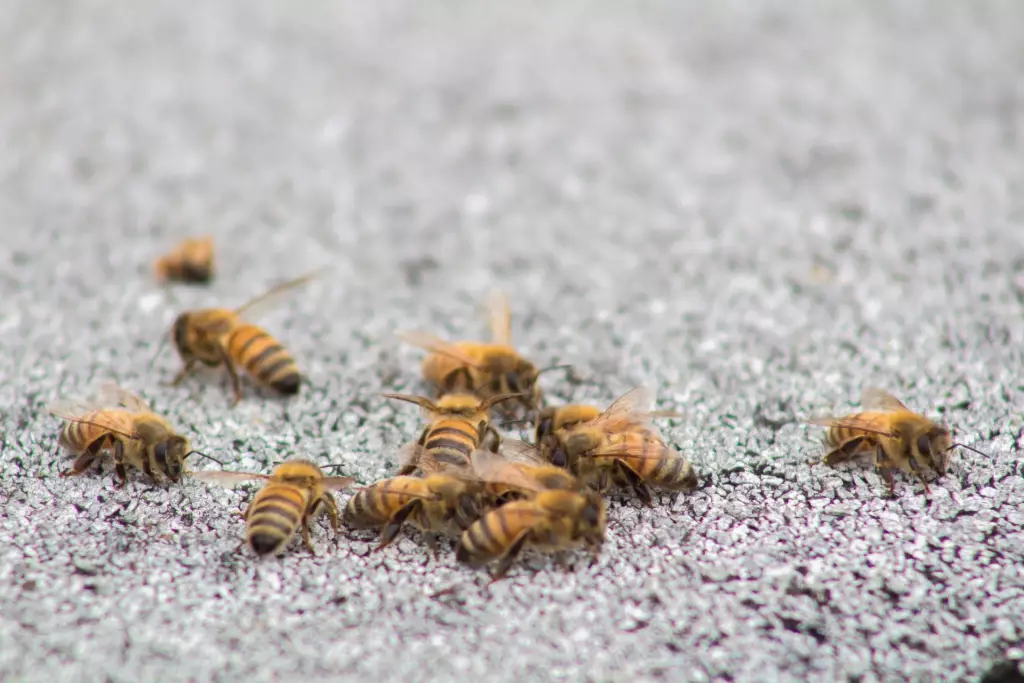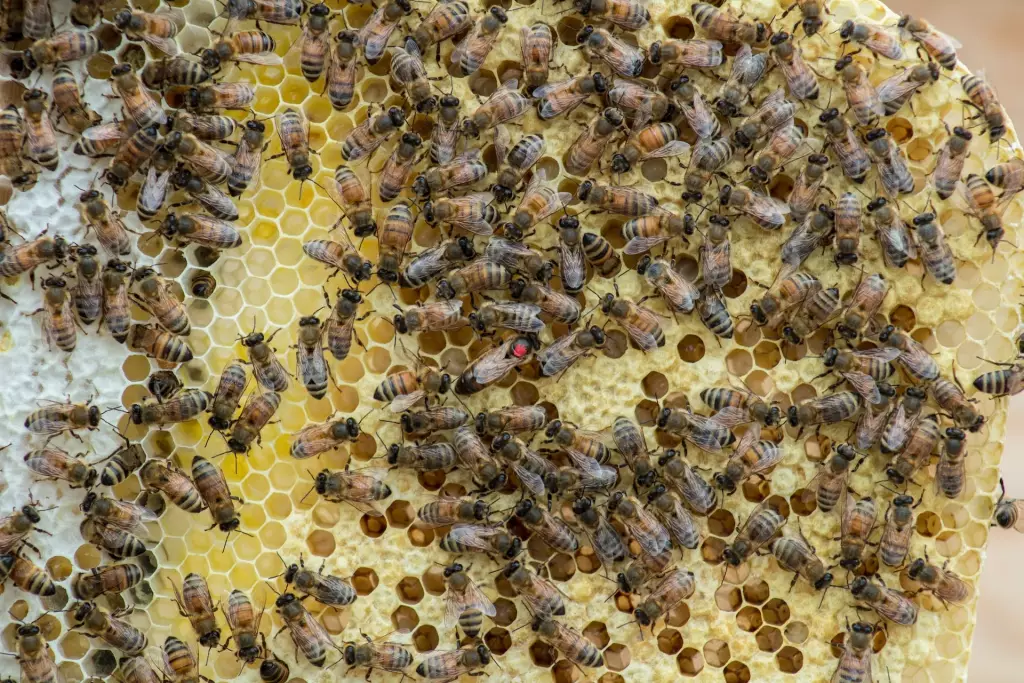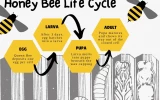What Time of Year & How Often Do Bees Mate?
To ensure the survival of honey bees, the queen bee must mate with drone bees and lay eggs. She lays new female worker bees, virgin queen bees, and some drones throughout her lifetime. But how often and at what time of year do bees mate? Let’s hear the buzz.
Honeybees actively mate during the entire summer season. It’s the time of year when temperatures of at least 69 degrees Fahrenheit are ideal for mating. The queen honey bee may make two or three mating flights over the course of several days. She will mate between 6 and 24 times during a mating flight.
The warm season starts in June and lasts until October, just before winter. Queen honeybees mate with drones in the open while flying outside the hive, usually in the afternoon. To accomplish this, the queen leaves the nest or hive and goes on mating flights to meet potential drones.
Summary
- During their mating flights, queen bees will typically mate with 10 to 20 drones.
- After mating, the queen will never leave the hive again unless the colony swarms and she joins the swarm.
- In cases of emergency, worker bees can lay eggs, but because they do not go on a mating flight, their eggs are unfertilized.
- The drone bees' only duty is to mate, and they die shortly after mating with a queen.

On this page:
What Time of Year Do Bees Mate?
Honeybees mate during the warm season, which is from summer to autumn, just before the cold weather.
Because queen bee mating occurs outside in the open, the weather is crucial.
The factors that are ideal for a successful honeybee mating are as follows:
- Temperatures of at least 69° F (but not exceeding 104° F)
- There isn't too much wind.
- There is no rain.
- Drones within a mile of the queen bee.
Poor weather will cause a queen's mating to be delayed, as will her ability to begin laying eggs.
If a virgin queen is contained in her hive for more than three weeks due to harsh weather conditions, or if she is unable to mate during this time, she will eventually begin to lay eggs. In this case, she will only lay unfertilized eggs, which will later emerge as drones.
How Often Do Bees Mate?
The queen honey bee will mate high in the air between 6 and 24 times during one mating flight. She may make two or three mating flights over several days.
The virgin queen honey bee leaves the hive or nest to mate. She will have taken several previous short flights, which will have helped strengthen her wings.
Honeybees mate to increase colony genetic diversity which is vital for colony productivity and disease resistance.
Honeybees mate in order to reproduce and sustain the bee population for future generations.
How Do Honeybees Mate?
The virgin queen bee takes a few days to mature after emerging from her cell. She must allow her wings to dry and expand, as well as her glands to mature. She'll take her first mating flight when she's ready.
During the first 1–2 weeks of her adult life, the queen bee mates with drones. She can take multiple mating flights and can mate with up to 20 male honeybees.
It’s worth noting that the queen does not mate with her own drones. The drones she mates with should come from other colonies.
The drone's only duty is to mate, so he waits.

When she is ready to mate, the queen flies to a drone congregation area or drone assembly area, which resembles a mini-swarm of male honeybees.
These congregational areas range in width from 100 to 700 feet and in height from 50 to 125 feet above the ground.
Drones emit a specific pheromone that attracts queens. When she arrives, the mating takes place in the air with several drones.
The drone will fly over a queen and position himself so that his thorax is above her abdomen. An endophallus is a drone appendage that is tucked within his body and inverted at the same time.
The male honeybee will insert his endophallus to ejaculate semen into the queen's sting chamber.
Over the next few days, the queen will conduct several mating flights, leaving a trail of dead drones. This helps to diversify the genetics of the hive and reduces inbreeding.
After successful mating, the drone attempts to fly away, but the endophallus stays in the queen. This will result in ripping the lower half of his abdomen apart and killing him.
After mating, the drones die, but the mated queen lives and returns to the nest as the new queen bee.
The drone will leave behind what is known as a "mating sign" in the queen during the process. The drone endophallus and mucus contain the mating sign.
Other drones will mate with the queen and attempt to remove the existing mating sign, which they may or may not succeed in doing.
The queen will need enough sperm to last a lifetime, which could be up to five years.
When the queen mates, she receives approximately 6 million sperm from each male. She stores up to 100 million sperm in her oviducts.
Only five to six million are stored within the queen's spermatheca.
Once the queen's spermatheca is full of sperm, that will be enough for her to be able to lay eggs for the rest of her life.
Throughout her life, the queen only uses a few of these sperm at a time to fertilize eggs. If a queen's sperm runs out during her lifetime, new generations of queens will mate and start their own colonies.
What Happens After Bees Mate?
When the queen begins laying eggs, she will do so for the rest of her life.
The mated queen begins to lay eggs within 3 or 4 days after returning permanently to the colony. The next generations of honey bees will emerge.
Worker bees construct cells in which the queen will lay her eggs—horizontal cells for queens, and vertical cells for workers and drones. Drone cells are larger than worker cells.
When the worker bees feel the queen needs to be replaced, they form horizontal cells. They build these cells away from the queen's nest.
When the queen lays an egg, she determines whether it will be fertilized based on the needs of the colony. The egg is fertilized when she fills worker cells, but it is not fertilized when she fills drone cells.
The queen has complete control over the sex of her offspring. As eggs pass through the ovary and into the oviduct, she can determine whether an egg is fertilized.
Unfertilized eggs develop into drone honey bees, whereas fertilized eggs become female workers and queens.
Female worker bees number in the thousands and perform all the colony's jobs except one. Worker honeybees can't mate, so they cannot lay fertilized eggs.
The worker bees inherit both their mother's and father's genes. But the drones only have their mother's genetics.
Workers can lay eggs that are unfertilized because they do not go on a mating flight. If allowed to develop into adults, their eggs become male bees.
Only queen bees can produce both male and female bees.

The honey bee colony is a symbiotic superorganism.
In order for the colony to succeed and have a productive queen, it must have an adequate number of workers and drones to perform the various functions of the colony, and the queen is responsible for ensuring this.
Queenright colonies are honeybee colonies that have a queen capable of laying fertile eggs.
By emitting pheromones, the queen will be able to communicate her capabilities to the workers in the hive or nest.
If the workers are not satisfied with the queen's ability to lay fertile eggs, the colony will rear a new queen to replace the old one.
This procedure, known as queen rearing, is referred to as a "supersedure."
Honeybees also reproduce at the colony level. The colony as a whole can reproduce through a process known as "swarming."
The colony population will split as a result of swarming. Half of the bee colony will migrate to a new location to establish a new home.
The old queen departs with the swarm, leaving the remaining colony queenless.
The remaining colony will now rear its new queen.
The new queen must go through pupal development, mature, mate, and begin laying eggs.
This causes a break in brood production and reduces colony population and productivity.
But the cycle will keep going.
